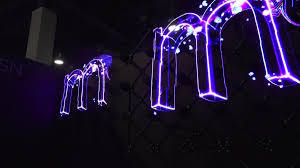The advertising industry has always been driven by innovation, with brands constantly searching for new ways to capture consumer attention. One of the most exciting advancements in this space is holographic advertising—a technology that creates immersive, 3D visuals that appear to float in midair. These holographic ads in retail and events are transforming the way businesses interact with their audiences, delivering more engaging and memorable experiences than traditional digital screens.
As digital advertising trends continue to evolve, businesses are looking for ways to stand out in a crowded marketplace. Holographic advertising in marketing not only enhances engagement but also improves customer retention and brand recall. In this blog, we’ll explore what holographic ads are, how they are shaping the retail and event industries, their key benefits, and what the future holds for this groundbreaking technology.
What Are Holographic Ads?
Holographic ads are a form of digital advertising that uses advanced 3D projection technology to create lifelike, high-definition images that appear in physical space without the need for special glasses. Unlike flat digital screens, these 3D holographic ads for events provide depth and motion, making them far more eye-catching and engaging.
These ads can be interactive, allowing users to engage with the content through gestures or touchless commands. Businesses can leverage holographic advertising solutions to create dynamic product showcases, brand storytelling, and even interactive customer experiences.
How Holographic Ads Are Transforming Retail
1. Enhancing Customer Engagement
In a world where consumers are constantly bombarded with ads, businesses must find innovative ways to capture attention. Holographic ads in retail stand out because they are visually striking and interactive. Unlike static billboards or digital screens, holograms create a sense of wonder, making customers more likely to stop, watch, and remember the message.
Retailers can use 3D holographic product ads to showcase their latest collections in an engaging way. Instead of a simple poster, imagine a sneaker brand displaying a floating, rotating 3D shoe that customers can explore from every angle. This level of interaction leads to higher engagement rates and increased purchase intent.
2. Virtual Product Displays
Retail stores often struggle with space constraints, limiting the number of products they can physically showcase. Holographic advertising in marketing solves this problem by enabling brands to display virtual products in a lifelike manner.
For example, an electronics retailer can use holographic displays in retail stores to showcase the internal components of a smartphone or laptop, allowing customers to see what’s inside without needing physical disassembly. This approach enhances transparency and builds trust in the product.
3. Personalized Shopping Experiences
The future of retail lies in personalized shopping experiences, and holographic technology plays a major role in this evolution. AI-powered holograms can analyze customer preferences and deliver customized product recommendations in real-time.
Imagine a holographic assistant greeting shoppers and suggesting outfits based on their past purchases. This level of personalization not only improves customer satisfaction but also increases sales conversions.
The Role of Holographic Ads in Event Marketing
1. Immersive Brand Experiences
Events and exhibitions rely heavily on engagement, and holographic advertising for events helps brands stand out in a crowded venue. Large-scale holographic projections can create visually stunning experiences that captivate audiences and leave a lasting impression.
For example, at a music festival, a beverage brand could project a massive 3D hologram of its latest drink, spinning and shimmering in midair. This kind of immersive advertising experience ensures high recall value and boosts brand recognition.
2. Product Launches & Demonstrations
Product launches are crucial for any brand, and 3D holographic event ads take these events to the next level. Instead of traditional presentations, brands can use holographic displays to demonstrate product features in an interactive and visually appealing way.
For instance, a car manufacturer like BMW launching a new model can use holographic ads to showcase the vehicle’s design, highlight key features, and even allow potential buyers to customize colors and interiors in real-time through an interactive interface. Brands like Audi and Mercedes-Benz have already embraced cutting-edge technology in their marketing campaigns, offering virtual and interactive experiences to engage consumers.
3. Interactive Advertising at Events
One of the biggest advantages of holographic advertising in marketing is the ability to create interactive experiences. Event organizers can integrate holographic ads into their setup to provide attendees with dynamic, engaging content.
For example, a holographic brand ambassador can welcome guests, provide information about the event schedule, and even answer FAQs through AI-powered responses. This reduces the need for physical guides while enhancing the visitor experience.
Benefits of Holographic Advertising
- Higher Engagement Rates: 3D visuals naturally attract more attention than traditional ads.
- Memorability: Due to their immersive nature, people are more likely to remember holographic content.
- Interactivity: Consumers can interact with the content through gestures, voice commands, or touchless controls.
- Cost-Effective in the Long Run: While the initial investment may be high, holographic ads reduce recurring expenses related to print advertising.
- Eco-Friendly Alternative: Digital holographic advertising solutions reduce the need for printed materials, helping brands become more sustainable.
The Future of Holographic Advertising
The future of holographic advertising in marketing looks promising, with continued advancements in AI, augmented reality (AR), and machine learning making this technology even more accessible. As digital advertising trends evolve, brands will increasingly adopt holographic ads to deliver hyper-personalized, interactive experiences.
With innovations like 5G-powered holographic ads, we may soon see real-time, location-based advertising that dynamically adjusts based on audience demographics and preferences. The integration of holographic displays in retail stores and public spaces will further revolutionize the advertising landscape.
Conclusion
Holographic advertising is no longer a concept from science fiction—it is already here, reshaping how brands interact with consumers. From holographic ads in retail that enhance shopping experiences to holographic advertising for events that create unforgettable brand interactions, this technology is set to redefine digital advertising.
Businesses that adopt 3D holographic advertising early will gain a competitive edge by providing customers with visually stunning, engaging, and immersive ad experiences. As the industry continues to evolve, holographic ads will become a key pillar of modern advertising strategies.
Are you ready to embrace holographic advertising solutions and step into the future of marketing? Now is the time to integrate this cutting-edge technology into your brand strategy and captivate your audience like never before!








Leave a Reply